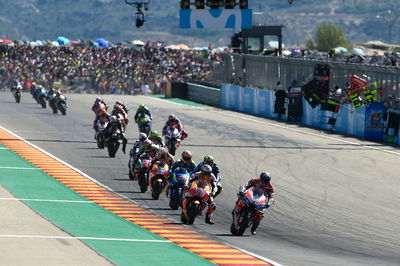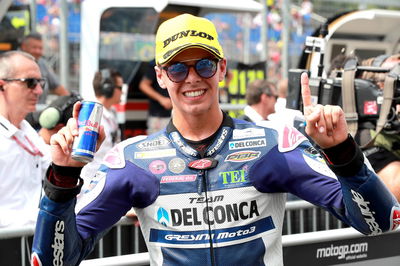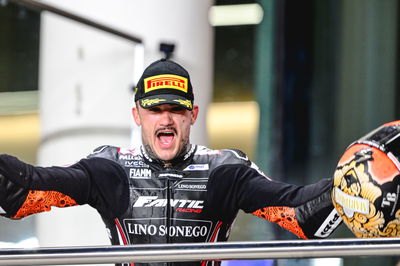MotoGP considering Moto2, Moto3 schedule swap?

MotoGP riders complaining of a change in grip for the race compared to practice is nothing new, having often been put down to how their Michelin (and previously Bridgestone) rubber interacts with the Dunlop tyres used in Moto2.
But it sounds like the issue might finally be addressed for 2019.
In order for MotoGP to be on track at the same time each afternoon throughout a race weekend, the premier-class is sandwiched between Moto3 and Moto2 for practice and qualifying (Moto3-MotoGP-Moto2), before the schedule switches to Moto3-Moto2-MotoGP for the warm-up and races on Sunday.
Speaking in Thailand on Thursday, Pramac Ducati's Jack Miller confirmed that a revised order could be discussed in the upcoming Safety Commission meeting.
"It's not only for us, for the Moto2 guys as well, because they are used to riding on a track with Michelin rubber on it all weekend and then they go for the race and there's no Michelin rubber," Miller said.
"Then for us, especially the first 5-6 laps [of the MotoGP race], it makes it really hard.
"If we can try to make track conditions [for practice] a little more similar to the race, it can be better."
Miller said the perfect solution is to put "Moto2 on Michelins!" A more realistic change would be to either swap the Moto3 and Moto2 practice and qualifying sessions (Moto2-MotoGP-Moto3) so that MotoGP follows Moto2 all weekend, or change the race day schedule to match the current practice order.
Moto2 will have even bigger 765cc Triumph-powered engines in 2019. Although Moto3 also uses Dunlop tyres, their 250cc engines leave far less rubber on the track.
"[A change] would be better for us and also for [Moto2, if practice was moved before MotoGP], because if you watch the last six or something Moto2 qualifying sessions most of the best lap times have been set in the first or second flying lap," explained the Australian, highlighting that the fresh Michelin rubber seems to give a performance boost at the start of the Moto2 sessions.
"It was amazing last week to watch Binder actually crack the pole time of Marcel [Schrotter] because Marcel was the first on track, he got the best conditions, he got a clean lap and no-one could match him until the last couple of minutes.
"I think we've got to work on it and the guys at Dorna and such are working on [the schedule] to try and make it a little bit smoother. We'll see what plans they come up with in the Safety Commission tomorrow.
"We've always sort of said about it, but last week [in Aragon] it was kind of a big issue.
"At tracks like Aragon [the MotoGP race following Moto2] makes a lot difference and also even Misano. Where it's hot especially, or when there are big accelerations.
"Here it might not be such a problem, but then Phillip Island or somewhere like that where there is a lot of rubber being laid down, it can make a difference for sure."
Movistar Yamaha have been among the teams most perplexed by the change in grip on race day, but Miller pointed out it's not clear cut - Valentino Rossi often improves relative to qualifying, while team-mate Maverick Vinales drops back.
"Hard to say because Yamaha, especially Rossi, always seems to go well in the race. I don't know if that's coming from his experience or that the bike is working better without the Michelin rubber [on the track at the start].
"Seems to be he's always there, but then the other guy [Vinales] is always struggling in the first 5-6 laps and then come the end of the race he's able to match the guys at the front for pace. So I think it's hard to say what's happening there."
In addition to the Dunlop influence, Miller revealed that the current Michelin MotoGP rubber is especially sensitive to early-race overheating.
"The biggest thing with these Michelin tyres is not to overheat them too early," he said. "Petrucci and myself got caught up with Lorenzo's crash at Turn 1 [in Aragon], I think we were 13th or 14th at one point.
"So we had to push from the start and the temperature and pressure of the rear tyre rises quite a lot and then it never comes back down! You stuck on that all the race. But if you can gradually build-up the temperature, it's a lot better for the tyre and you have a lot more tyre left at the end of the race.
"So you can never really push [from the start], you have to wait almost during the first 5 laps and try to control the situation a little bit more."
MotoGP race preparation is also not helped by the need to push for fast lap times at the end of FP1, FP2 and FP3, to help ensure direct access to Qualifying 2.
"We get such a short time with FP1, FP2 and FP3 almost being like qualifying sessions - you've always got to have 10-15 minutes at the end to put new tyres on the bike. So really you only have about 20-minutes of a session on track working for the race."
There has been talk in the past of revising the direct Qualifying 2 entry so that only the top ten in FP3 would count, not the combined FP1-FP2-FP3 top ten.
That would leave riders free to work on race pace throughout Fridays, and also mean riders would push flat-out in FP3 even if weather conditions were worse than day one. The downside is that it would make Friday's less exciting.
"We are trying to find something or some solution that works because the FP1, FP2 and FP3 counting towards qualifying makes it so interesting for everybody at home and at the event, because you have to watch every session, see what's going on and how the weekend is developing," Miller said.
Miller was sixth and top Ducati during MotoGP's debut test at Buriram in February.












